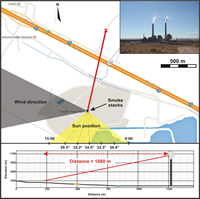Validation of the SO2 camera for high temporal and spatial resolution monitoring of SO2 emissions
Smekens J.-F., M.R. Burton, A.B. Clarke (2015).
Journal of Volcanology and Geothermal Research, Volume 300, Pages 37-47, doi:10.1016/j.jvolgeores.2014.10.014.
Abstract
Ground-based measurements of sulfur dioxide (SO2) are a key part of monitoring networks at many volcanic centers. SO2 camera systems represent an attractive addition to conventional spectroscopic methods such as COSPEC or DOAS, because they offer higher sampling rates (up to 1 Hz) and two-dimensional concentration mapping which provides additional contextual information for emission rate calculation and interpretation. Here we present the results of an SO2 camera development project and corresponding validation experiment conducted at a coal-burning power plant in Arizona (USA), where the emissions are independently measured. Emissions of SO2 and other acid gases are regulated in the United States, and hourly data are publicly reported by the US Environmental Protection Agency (EPA). We measured the emissions from two exhaust stacks that had an average combined rate of 8.2 ± 2.1 × 10− 2 kg s− 1 (7 ± 1.8 t d− 1) over a period of 3 h. Masses integrated from our dataset are within 10–20% of the emissions reported by the EPA. The contextual information contained in the images allowed the identification and measurement of the individual plumes from each stack. Measured emission rates decrease with increasing distance from the source, pointing to an apparent loss of SO2 primarily by gas dilution processes, with SO2 concentrations dropping below the detection limit at the edge of the plume at distances > 200 m from the source. Cross-sections very close to the vent (within 50 m; ~ 2 vent diameters), through the optically thick condensing part of the plume, yielded emission rates lower than those reported to the EPA. This near-vent discrepancy is interpreted to be the result of light dilution effects due to attenuation and reflections off the surface of the condensing plume. This work is the first reported validation of emission rate measurements produced by an SO2 camera in a volcano-like geometry, and demonstrates that reliable emission rates can be measured, but also emphasizes the importance of the selection of the cross-section locations.
http://www.sciencedirect.com/science/article/pii/S0377027314003126


